A Bacteriophage possesses viral proteins, which can disrupt their host cell, i.e. Bacteria. It first attaches to the susceptible bacterial cell and injects its genetic material into the host cell. The viral genome within the host cell takes over the cell machinery and uses the bacterial components to release viral proteins.
Eventually, the viral proteins assemble to form virus particles that release out of the host cell by causing cell lysis. In some cases, the viral genome remains integrated with the bacterial genome. Bacteriophage was first studied by F.W. Twort (1915). Later the term bacteriophage was given by Felix de Herelle (1917).
After that, he found that the bacteriophage is useful for the patient suffering from dysentery caused by Bacillus dysenteriae and introduced Phage therapy. In this context, we will talk over the classification, features, morphology and life cycle of the bacteriophage.
Content: Bacteriophage
Definition of Bacteriophage
If we break the term bacteriophage, we can remember the meaning, viz. Bacterio means bacteria and Phage means invaders or eaters. Therefore, a bacteriophage can define as a virus, which invades the bacterial cell machinery. Bacteriophages show a parasitic relationship with its host cell, i.e. bacteria. It not only infects the host (bacteria) but also controls the machinery of the host. These are ubiquitous in nature.
Classification
Based on genome and morphology, the bacteriophages are classified by ICTV (International Committee on Taxonomy of Viruses).
Based on the genome: Bacteriophage can be classified into the following four types:
- ds-DNA
- ss-RNA
- ds-DNA
- ss-RNA
| Bacteriophage family | Genome | Examples | Diagram |
|---|---|---|---|
| Myoviridae | Genome: Linear, ds-DNA | Coliphage T2, T4, T6 | 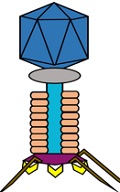 |
| Styloviridae | Genome: Linear, ds-DNA | Coliphage T1, T5 |  |
| Pedoviridae | Genome: Linear, ds-DNA | Coliphage T3, T7 |  |
| Corticoviridae | Genome: Circular, ds-DNA | Pseudomonas phage MP2 |  |
| Tectiviridae | Genome: Linear, ds-DNA | Phage PRD1 | 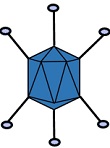 |
| Plasmaviridae | Genome: Linear, ds-DNA | Phage MV-L2 |  |
| Microviridae | Genome: Circular, ss-DNA | Coliphage ɸX174 |  |
| Inoviridae | Genome: Circular, ss-DNA | Coliphage fd | |
| Cystoviridae | Genome: Segmented, ds-RNA | Phage ɸ6 |  |
| Leviviridae | Genome: Linear, ss-RNA | Phage MS2 |  |
Characteristics
- A bacteriophage is smaller than the bacteria.
- The genetic material of bacteriophage can be either DNA or RNA and linear or circular.
- Its genome size is about 49 kb.
- The bacteriophage size ranges from 25-200 nm in length.
- Bacteriophage can be either infectious or non-infectious to the host cell.
Structure of Bacteriophage
The morphology of bacteriophage includes the following components:
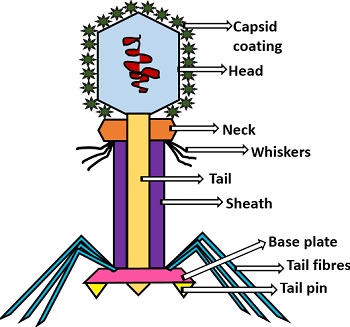
Head:
- It is elongated and hexagonal in shape.
- Head of the bacteriophage possesses a prismoid structure.
- It is surrounded by an envelope called a capsid.
Capsid:
- It is produced by the identical protein subunits called capsomeres.
- It contains around 2000 capsomeres.
Genetic material:
- It is 50 nm long and can be either DNA or RNA.
- The structure of genetic material can be linear or circular.
- It is tightly packed inside the head.
Neck:
- It is also called a collar, which connects head and tail.
- It possesses a circular plate-like structure.
Tail:
- It resembles a hollow tube.
- A tail is surrounded by a protein sheath.
Sheath:
- It is composed of around 144 protein subunits.
- The sheath of the bacteriophage is highly contractile.
- It contains 24 rings.
Base plate:
- It is hexagonal in shape.
- The base plate is present at a distal end.
Tail fibres:
- These are attached to the base plate.
- It appears long and thread-like filaments.
- Tail fibres induce host specificity, or they are host-specific.
- They are generally found 6 in number.
- Size: 130x2nm
Spikes:
- It is also called a tail pin.
- Spikes recognizes the receptor sites of the host cell.
Life Cycle of Bacteriophage
Lytic and lysogenic cycles are the common phases of the bacteriophage life cycle.
Lytic Cycle
It is also called Virulent or Infectious cycle. It includes the lytic phages. The phages of a lytic cycle can infect or kill the host cell, due to which the cycle is known as a virulent phase. It includes the following steps:
- Attachment
- Adsorption
- Penetration
- Replication
- Assembly
- Cell lysis
Attachment: In this step, a tail pin or spike recognizes the receptor sites on the host bacterial cell and attaches to it. After that, the tail fibres of the bacteriophage attaches to the surface of the bacteria.
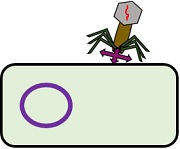
Adsorption: In this step, the amino groups of the host cell reacts with the carboxyl group of the bacterial cell and vice versa. After the reaction, the tail fibres secrete a lytic enzyme. This enzyme creates a hole in the host cell through which a viral genome moves into the host cell cytoplasm.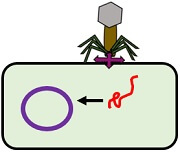
Penetration: This step is also known as “Injection”, in which the phage genetic material penetrates the genetic material of the host.
Replication or biosynthesis: After the penetration, the mRNA moves out of the nucleus to the cytoplasm, and the viral genome degrades the host genetic material. Then mRNA transcribes and translates to form protein capsid, which leads to the biosynthesis of other components.



Assembly: It also refers as “Maturation”. At this stage, all the components of bacteriophage assemble to produce new daughter or progeny virions.

Lysis: At this stage, the virus kills the bacterial cell by cell lysis and releases about 100-200 progeny virions.
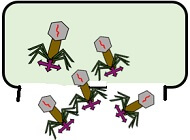
Lysogenic Cycle
It is also termed as a Temperate or Non-infectious cycle. The phages that participate in this cycle are known as “Lysogenic phage”. These phages do not kill or infect the bacterial cell, due to which a lysogenic phase is considered as a non-infectious phase. It includes the following steps:
- Attachment
- Penetration
- Incorporation of genetic material
- Replication
- Cell division
- Induction
Attachment: In this step, lysogenic phage first recognizes the receptors site of the host through their spikes. After recognition, tail fibres attach onto the host cell surface.
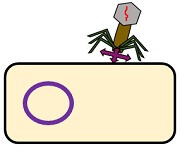
Penetration: It is also the same as the lytic phase, in which the tail fibres release a lysogenic enzyme to create a pore through which a viral genome goes into the cytoplasm of the host cell.
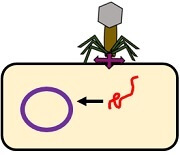
Incorporation of genetic material: It is also called as “Integration of genetic material”. At this stage, phage DNA incorporates into the genetic material of the host genetic material, which forms a complex (Prophage). Prophage is a temperate phage, which remains non-active, i.e. it is not able to produce new progenies.
This step is simply the recombination of phage and the host’s genetic material, which does not involve the transcription and translation processes.

Replication: During favourable conditions, prophage replicates when the bacterial genome replicates and pass onto the daughter cells.

Cell division: In this stage, a cell divides into two identical daughter cells.

Induction: It has two conditions:
- The prophage can remain in the dormant state inside the host cell.
- Secondly, prophage can continue the lytic cycle by the induction of UV-rays or heat treatment.
Significance
- It helps in the identification, classification and detection of pathogenic bacteria.
- It acts as a biocontrol agent by killing the bacteria that are involved in soil and water pollution.
- To study the concept of evolution, it also acts as the modal organisms.
- Bacteriophages have significant use in genetic engineering.
- In space microbiology, it is used as a radiation detector.
- It is significantly used in the treatment of many diseases caused by bacteria, also known as phage therapy.
- Bacteriophages play a central role to control bacterial plankton growth.
- In horticulture, these are used in the form of a spray to protect plants and vegetables.
- Also, acts like biocides such as disinfectant to clean up the environmental surfaces. E.g. In hospitals.
Therefore, a bacteriophage shows a wide range of ecological, molecular and biomedical significance.
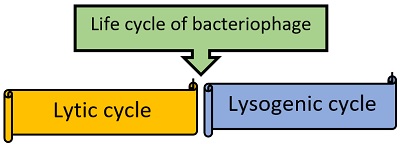
Very insightful article. thanks for sharing